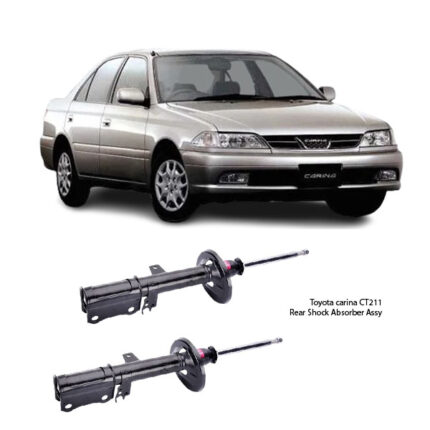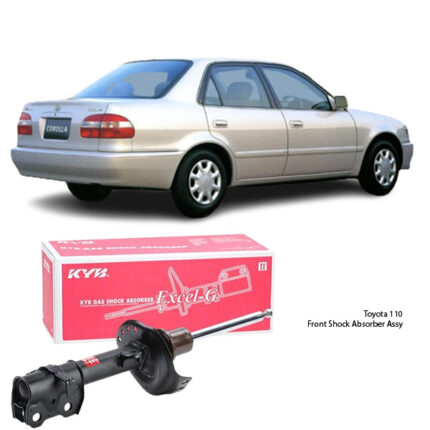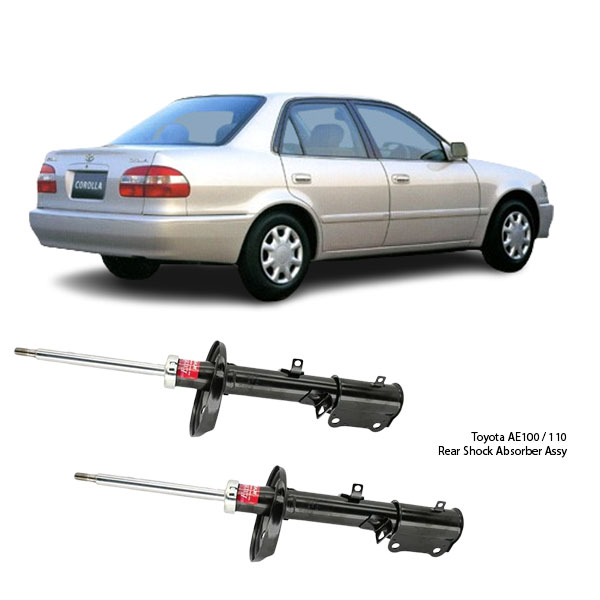Get Toyota AE100 / 110 Rear Shock Absorber Assy 333116 in Kenya
The Rear Shock Absorber Assembly is a vital part of a vehicle’s suspension system, responsible for controlling the vertical movement of the rear wheels, ensuring road contact, stability, and ride comfort. It quietly performs its job in the background but has a significant impact on how a vehicle handles, responds to bumps, and maintains balance under varying load and road conditions.
Without properly functioning rear shock absorbers, even the best engine and braking systems are compromised, as they rely on consistent tire contact with the road. This makes the rear shock absorber assembly not just a comfort component but a critical safety feature as well.
What Is a Rear Shock Absorber Assembly?
A Rear Shock Absorber Assembly is a suspension component mounted near or directly on the rear axle, designed to absorb and dissipate the energy generated when a vehicle moves over uneven surfaces. It works alongside springs, which absorb road shock, while the shock absorber dampens the energy to prevent oscillations or bouncing.
A typical rear shock absorber assembly includes:
-
The Shock Body (Tube): Houses hydraulic oil or gas.
-
Piston and Rod: Move inside the body, displacing fluid or gas to control motion.
-
Dust Boot: Protects internal parts from debris and contamination.
-
Mounting Bushes and Brackets: Connect the shock to the chassis and axle.
-
Optional Coil Spring (in coilover shocks): Some designs include a coil spring integrated with the damper.
Depending on the vehicle, the rear shock absorber can be part of a coil spring and shock assembly (coilover) or separate from the spring.
How It Works
When a rear wheel moves over a bump:
-
The coil spring compresses, absorbing the initial impact.
-
The shock absorber piston is pushed into the oil- or gas-filled tube.
-
Resistance to this motion dissipates energy as heat.
-
The shock absorber controls the rate at which the spring returns to its normal shape.
-
This process reduces bounce, prevents sway, and maintains consistent tire contact.
The damping action keeps the car from bouncing excessively, swaying during cornering, or diving and squatting under braking and acceleration.
Types of Rear Shock Absorbers
-
Twin-Tube Shocks:
-
Two cylinders: one for the piston and one as a reserve chamber.
-
Common in standard vehicles.
-
Cost-effective but can overheat under heavy use.
-
-
Mono-Tube Shocks:
-
Single cylinder with a floating piston.
-
Offers better heat dissipation and performance consistency.
-
Often used in performance and off-road applications.
-
-
Gas-Charged Shocks:
-
Filled with nitrogen gas to minimize foaming.
-
Improves damping performance and reduces fade.
-
-
Coilover Shocks:
-
Combine a coil spring and shock into one unit.
-
Adjustable ride height and damping in performance applications.
-
-
Air Shocks (on some luxury or utility vehicles):
-
Use air pressure to adjust ride stiffness or height.
-
Common in vehicles with load-leveling suspension systems.
-
Functions of the Rear Shock Absorber Assembly
-
Dampens Rear Suspension Movement: Controls the up-and-down motion after a bump.
-
Maintains Traction: Keeps rear tires in consistent contact with the road.
-
Enhances Load Handling: Supports the vehicle under various load conditions.
-
Improves Comfort: Minimizes vibrations and jolts for rear passengers.
-
Increases Stability: Reduces swaying or fishtailing when turning or under acceleration.
Advantages of a Good Rear Shock Absorber
-
Smooth Ride Quality: Absorbs irregularities and keeps the cabin stable and comfortable.
-
Better Handling: Provides controlled movement in corners and when changing lanes.
-
Shorter Braking Distance: Prevents rear lift that compromises braking efficiency.
-
Tire Longevity: Promotes even tire wear and better traction.
-
Enhanced Safety: Ensures vehicle behaves predictably under braking, acceleration, and in emergencies.
-
Reduced Wear on Other Suspension Parts: Prevents premature wear of springs, bushings, and control arms.
Disadvantages of a Faulty or Worn Rear Shock Absorber
-
Unstable Rear-End Behavior: Leads to oversteering, especially in sharp corners.
-
Excessive Bouncing: The rear of the vehicle continues to bounce after hitting a bump.
-
Longer Braking Distance: Less traction due to poor rear wheel contact with the road.
-
Rear-End Squat: Under hard acceleration, the vehicle rear sinks, affecting balance.
-
Noise and Vibration: Clunking or rattling from worn mounts or internal damage.
-
Increased Tire Wear: Irregular wear patterns such as cupping or scalloping.
Signs of a Worn Rear Shock Absorber
-
Fluid Leaks: Visible oil on the shock body.
-
Rear of the Car Feels Loose: Especially when cornering or going over speed bumps.
-
Uneven or Rapid Tire Wear: Caused by poor shock damping.
-
Unusual Noises: Rattling, clunking, or squeaking over bumps.
-
Poor Ride Comfort: Excessive bouncing and vibrations in the rear seats.
-
Visual Damage: Corroded, dented, or cracked housing or mounts.
-
Failing Bounce Test: If the vehicle bounces more than once after pushing down on the rear.
Lifespan and Replacement Interval
Most rear shocks last between 60,000–100,000 kilometers, depending on driving habits, road conditions, and vehicle usage. Replacement may be needed sooner for vehicles frequently used for:
-
Off-roading
-
Towing or heavy hauling
-
Rough terrain or poorly maintained roads
How to Replace a Rear Shock Absorber Assembly
Tools Needed:
-
Jack and jack stands
-
Lug wrench
-
Wrench/socket set
-
Penetrating oil
-
Torque wrench
Steps:
-
Lift the Vehicle Safely: Support with jack stands and remove the rear wheels.
-
Locate Shock Mounts: Identify upper and lower mounting bolts.
-
Unbolt and Remove the Old Shock: Spray rusted bolts if necessary.
-
Install the New Shock: Position correctly and torque bolts to specifications.
-
Repeat on the Other Side: Always replace shocks in pairs.
-
Test Drive: Ensure improved stability and listen for abnormal sounds.
Note: Some vehicles may require removal of interior trim or access through the trunk for upper mount bolts.
Maintenance Tips
-
Visual Inspection Every Oil Change: Check for leaks, rust, and damage.
-
Replace in Pairs: Never replace just one rear shock—it can unbalance the suspension.
-
Check After Heavy Use: Long trips or carrying heavy loads may strain the shocks.
-
Monitor Tire Condition: Uneven wear can indicate failing shocks.
Follow us on Facebook for more parts.




